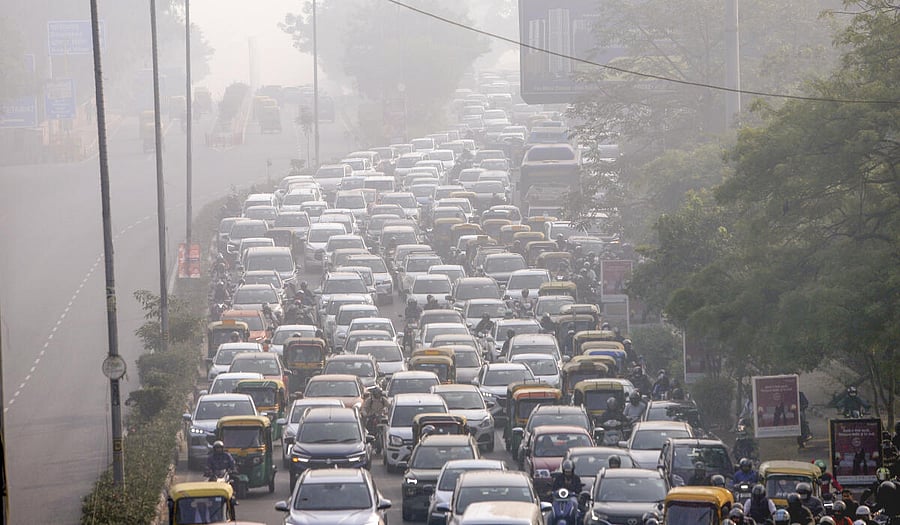
Vehicles move amid a traffic congestion during smog, at ITO, in New Delhi.
Credit: PTI
With Delhi’s air quality index breaching the 400 mark on a scale of 500, the Commission for Air Quality Management in the National Capital Region and Adjoining Areas has imposed a set of strict anti-pollution measures – known as Graded Response Action Plan (GRAP)-3. If the air quality deteriorates further, stricter norms (GRAP-4), under which the state governments can consider closing down schools for a few days, may also be in play. But all of these are essentially band-aid solutions to a problem that gets little attention from governments during the rest of the year when the air is cleaner.
For over a decade, the Narendra Modi government at the Centre has spoken of cleaning up the air that lakhs of residents in Delhi and its satellite cities—Noida, Ghaziabad, Gurugram, Faridabad and Greater Noida—are forced to breathe for nearly two months at the onset of every winter. Even after four Union environment ministers in 11 years, the formation of the CAQM in 2020 by an Act of Parliament, and repeated observations by the Supreme Court, the situation on the ground remains unchanged.
There are, in fact, two sets of realities—one for Delhi and another for satellite cities—though they share the same airshed. Each of India’s 10 most polluted cities lies in the National Capital Region (NCR), with Dharuhera on the Haryana-Rajasthan border topping the list and Delhi ranking sixth. Others on the list are Rohtak, Ghaziabad, Noida, Ballabgarh, Bhiwadi, Greater Noida, Hapur and Gurugram. Four of these are in BJP-ruled Uttar Pradesh and four in Haryana, but little is said about them compared to Punjab – ruled by the Aam Aadmi Party – and Haryana, where stubble-burning remains a recurring issue for five to six weeks each year.
The October air pollution rankings are based on an analysis by the Centre for Research on Energy and Clean Air (CREA), which uses data from the Central Pollution Control Board for 212 cities. These cities have been reporting PM2.5 concentrations below the National Ambient Air Quality Standards of 60 micrograms per cubic metre. These cities were chosen for analysis as they reported continuous data for more than 80% of the days.
According to the CREA analysis, Dharuhera recorded a PM2.5 concentration of 123 micrograms per cubic metre, compared to Delhi’s 107, Noida’s 112 and Ghaziabad’s 114.
Studies show that the transport sector is the leading source of PM2.5 emissions, particularly during winter. Vehicles are also a major source of greenhouse gas pollution, and as traffic slows during peak hours (5 pm-9 pm), pollution levels rise sharply.
Yet little has been done to establish an efficient and affordable bus service within the NCR or to link Delhi with its satellite cities. While the Delhi Metro offers excellent connectivity, its reach into the satellite cities is limited with poor last-mile connectivity issues. This has led to overdependence on private vehicles, auto rickshaws, taxis, and ride-hailing services.
An increasing number of vehicles on the roads cannot be a solution to Delhi’s worsening air. According to the official data, Delhi has nearly 80 lakh registered vehicles, with more than 11 lakh entering and exiting daily. The bus fleet, on the other hand, is woefully inadequate for Delhi and virtually non-existent within the satellite cities. There are virtually no reliable bus services connecting Noida, Gurugram and Ghaziabad, from where lakhs of commuters travel to Delhi every day. Poorly maintained roads and potholes make matters worse.
Way back in 1998, the Supreme Court had directed the Delhi Transport Corporation to maintain a fleet of 10,000 buses. Nearly three decades later, that target is yet to be met. Delhi has just 45 buses per lakh population (as per the 2011 Census), far short of the Union Ministry of Housing and Urban Affairs’ benchmark of 60 buses. In contrast, London has 90 buses per lakh population, Hong Kong has 80, Shanghai 69, and Seoul 72.
Dust control is another poorly addressed problem. Though road-sweeping vehicles and water sprinkling are in use on some roads, a simpler and more sustainable solution—landscaping—has been largely ignored. Consulting botanists to identify fast-growing, low-cost grasses and hedge species and planting them in open areas across NCR cities could significantly reduce dust in the air. If done before or during the monsoon, these green buffers would mature by winter, helping to trap dust and improve air quality.
After years of neglecting this simple, straightforward solution, Union Environment Minister Bhupender Yadav has finally instructed NCR authorities this week “to undertake roadside greening works on a mission mode so as to minimise dust generation.”
A third, lesser-known problem is the inadequate pollution monitoring data. While there have been allegations against the BJP government in Delhi of manipulating air quality data, Noida, Gurugram, Ghaziabad and Faridabad have too few monitoring stations to present an accurate picture.
For instance, Delhi, covering 1,483 sq km, has 39 monitoring stations. In comparison, Uttar Pradesh’s Gautam Buddha Nagar district (1442 sq km), which includes Noida and Greater Noida, has only six. The total number of such stations in GB Nagar, Gurugram, Ghaziabad, and Faridabad is less than half of Delhi’s. Dharuhera, the most polluting city in the NCR, has only one.
